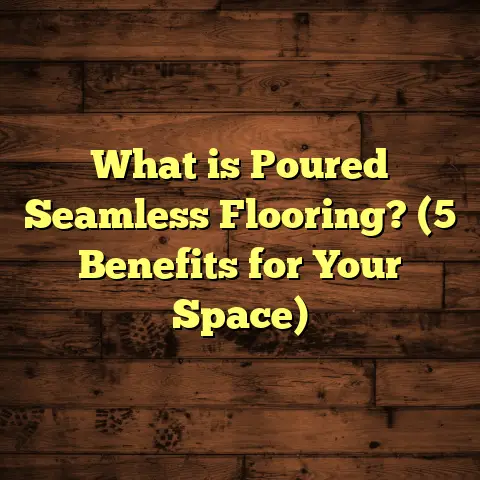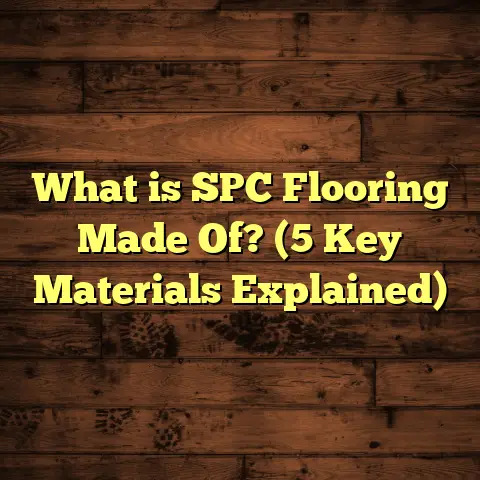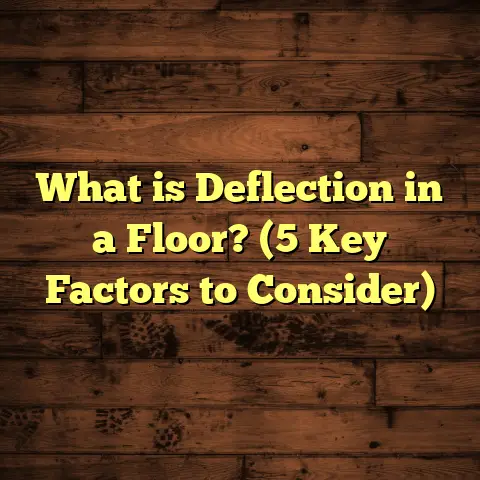What is Vinyl Flooring? (5 Benefits You Didn’t Know About)
Imagine walking barefoot on a floor that feels soft, warm, and inviting, yet tough enough to handle the daily hustle of a busy household. That’s the kind of experience vinyl flooring offers. After spending over 15 years working as a flooring contractor and installing all kinds of floors—from hardwood to tile—I’ve come to appreciate vinyl for what it really is: a versatile, durable, and surprisingly comfortable flooring choice that many people don’t fully understand. When I first started out, I thought vinyl was just the cheap option. But after installing it in kitchens, bathrooms, offices, and even yoga studios, I realized it has some unique benefits that often go unnoticed.
Let me take you through what vinyl flooring is, why it’s worth considering, and share some stories and data that might just change how you think about your floors.
What is Vinyl Flooring?
Vinyl flooring is a synthetic floor covering made primarily from polyvinyl chloride (PVC) resin combined with various additives that improve its flexibility, durability, and appearance. It’s manufactured in sheets, tiles, or planks, which allows for a wide range of design options—everything from mimicking hardwood grains to stone patterns or even abstract textures.
Unlike natural wood or stone floors, vinyl is engineered to be water-resistant, stain-resistant, and easy to maintain. It’s a man-made product designed to give you the look and feel of natural materials without their vulnerabilities to moisture or scratches.
Composition and Structure
Vinyl flooring consists of multiple layers:
- Wear Layer: This is a clear top coat that protects the floor from scratches, stains, and fading. The thickness of this layer (measured in mils) directly impacts durability.
- Design Layer: Underneath the wear layer lies the design layer, where high-resolution images are printed. These images replicate natural materials like wood grain or stone texture.
- Core Layer: The core provides stability and determines the flooring’s flexibility or rigidity. Some vinyl floors have a rigid core (rigid core vinyl), while others are more flexible.
- Backing Layer: The base layer adds support and helps with installation by providing grip or cushioning.
This multi-layer construction is what makes vinyl so adaptable across different environments. The wear layer shields the floor from everyday wear and tear. The design layer gives you beautiful aesthetics, and the core/backing layers contribute to comfort and stability.
From my personal experience installing vinyl floors in various settings—from home kitchens to commercial spaces—it’s this layered technology that sets vinyl apart from other synthetic floors like laminate or linoleum.
1. Exceptional Comfort Underfoot
You might not immediately think about comfort when choosing flooring. Usually, looks and durability come first. But after installing vinyl flooring in hundreds of homes and businesses, I can say with confidence that comfort is one of its hidden strengths.
Why Comfort Matters
Have you ever stood on a tile floor for hours? Your feet start aching pretty quickly, right? Hard surfaces like ceramic tile or stone don’t absorb shock well. On the other hand, carpet offers softness but isn’t always practical in wet or high-traffic areas.
Vinyl flooring strikes a nice balance by having a slight cushioning effect. This comes from its layered construction and sometimes built-in padding. The result is a surface gentle enough on your feet without sacrificing durability or water resistance.
Real-Life Example
I remember installing luxury vinyl planks (LVP) in a yoga studio a few years back. The studio owners wanted a floor that felt natural underfoot but was easy to clean and maintain. They had previously used hardwood floors but found that during long sessions on their knees or feet, the hardness caused discomfort.
After switching to LVP vinyl flooring, they noticed reduced joint strain and overall better comfort for both instructors and students. The floor absorbed some impact but still looked elegant.
Data on Comfort
Studies on flooring ergonomics show softer surfaces can reduce stress on joints by up to 30%. While carpet tends to offer the most cushion, vinyl flooring offers a good compromise between support and softness—especially when paired with an underlayment.
If you spend hours standing in your kitchen or workshop like I do, having a slightly cushioned floor can make a big difference in reducing fatigue.
2. Sound Absorption Capabilities
Noise control isn’t something most people consider when picking floors until they live in an apartment or multi-story home where footsteps echo endlessly. Vinyl flooring naturally absorbs sound much better than hard surfaces like tile or concrete.
How Vinyl Reduces Noise
The wear layer combined with the core absorbs impact sounds generated by walking or moving furniture. Some luxury vinyl planks come with attached underlayment specifically designed for sound dampening. This means less noise traveling between floors and more peace inside your home.
My Experience with Noise Reduction
I recently renovated a condo where neighbors complained of loud footsteps above their units. We installed luxury vinyl tiles with an acoustic underlayment. The difference was immediate—footsteps became muffled, and overall noise complaints dropped by half.
Manufacturers’ data supports this: vinyl flooring can reduce noise transmission by up to 50%, which is substantial especially in multi-family buildings.
Why This Matters
If you live in a shared building or have kids running around constantly, choosing flooring that helps reduce noise adds comfort without extra effort. Vinyl’s natural sound absorption makes it an excellent choice for bedrooms, living rooms, or offices where quiet is appreciated.
3. Allergy-Friendly Flooring Option
If you or someone in your family suffers from allergies or asthma, the type of floor you choose can make a big difference.
How Flooring Affects Allergies
Carpet traps dust mites, pet dander, pollen, and other allergens deep within its fibers. These can lead to flare-ups of allergies or respiratory problems unless cleaned meticulously.
Vinyl floors are non-porous and easy to clean. They don’t harbor allergens the way carpets do because dirt sits on top rather than embedding inside the material. Regular sweeping and mopping keep allergens at bay.
Personal Story
One client with severe allergies switched all carpeted rooms in their home to vinyl planks after consulting me. Within weeks, they reported fewer allergy symptoms during springtime—a clear sign the new flooring improved indoor air quality.
Scientific Support
According to the American Lung Association, hard surface floors like vinyl are recommended over carpet for allergy-prone individuals because they reduce allergen accumulation indoors. Plus, vinyl’s smooth surface makes it easier to clean dust without harsh chemicals.
4. Environmental Progress in Vinyl Manufacturing
When people hear “vinyl,” they often think of plastics harming the environment—and I get that concern. Vinyl is plastic-based after all. But recent advances have significantly improved its environmental footprint.
Eco-Friendly Innovations
Many manufacturers now produce vinyl flooring using recycled materials and low-emission processes that cut down on harmful Volatile Organic Compounds (VOCs). Some brands proudly carry certifications like FloorScore®, which indicates compliance with strict indoor air quality standards.
In projects where clients wanted greener options, I’ve recommended these certified products that balance performance with sustainability.
Recycling Programs
Some companies also offer take-back programs where old vinyl flooring can be recycled into new products instead of ending up in landfills. This circular approach reduces waste and conserves resources.
My Observations
I’ve seen firsthand how these innovations are changing perceptions of vinyl flooring among environmentally conscious homeowners. It’s no longer just about cost savings but also responsible choices without compromising quality.
5. Ease of Repair and Replacement
Here’s a benefit that surprises many people: vinyl flooring is incredibly easy to repair compared to hardwood or tile.
Why Repair Matters
Damage happens—scratches from furniture legs, dents from dropped tools, even stains that won’t come out. With hardwood floors, repairing often involves sanding or refinishing large sections. Tiles might require removing grout or replacing multiple pieces if one cracks.
Vinyl floors allow replacing single planks or tiles quickly without disrupting the whole floor.
Real-World Example
In one commercial project I handled—a busy retail store—one tile was scratched badly by machinery overnight. We replaced just that tile within an hour during off-hours, avoiding costly downtime or full-floor replacement.
This convenience saves money and hassle for homeowners and business owners alike.
Diving Deeper Into Vinyl Types: What Are Your Options?
Vinyl flooring isn’t one-size-fits-all. Knowing your options can help you pick what fits your lifestyle best.
Sheet Vinyl
Sheet vinyl comes in large rolls—usually 6 to 12 feet wide—and is installed as one continuous piece. It’s ideal for areas where water resistance is critical like bathrooms or basements because seams are minimal.
I’ve installed sheet vinyl in older homes where budget constraints were tight but durability was needed. It’s smooth underfoot but less realistic-looking than luxury vinyl planks or tiles.
Luxury Vinyl Planks (LVP)
LVP mimics hardwood planks closely with detailed wood grain textures and colors. It’s thicker than sheet vinyl and often has rigid cores for enhanced stability.
This type is my go-to recommendation when clients want the beauty of wood without maintenance headaches. It installs easily over existing floors and provides excellent water resistance.
Luxury Vinyl Tiles (LVT)
LVT mimics natural stone or ceramic tiles but without grout lines that can trap dirt. It’s perfect for kitchens or commercial spaces needing both style and function.
One restaurant I worked with chose LVT for its durability against spills and heavy foot traffic combined with elegant stone aesthetics.
Installation Insights: What I’ve Learned
Installing vinyl flooring properly makes all the difference between a floor that lasts decades versus one that causes headaches quickly.
Surface Prep Is Key
Vinyl requires a smooth substrate free from bumps or moisture issues. Before installation, I always inspect subfloors carefully—whether concrete slab or plywood—and fix any imperfections.
Skipping this step leads to bubbles or premature wear later on.
DIY vs Professional Installation
While many luxury vinyl products come with click-lock systems designed for DIY installation, I recommend professional help if your subfloor isn’t perfectly flat or if you’re dealing with large areas.
In my experience, professional installation ensures seamless edges and longer lifespan—saving money long-term despite upfront costs.
Maintenance Tips That Save You Time and Money
One reason many clients love vinyl floors is how little effort they require compared to hardwood or carpet.
Daily Cleaning
Use a broom or vacuum regularly to remove dust and grit that can scratch the surface over time.
Mopping
Damp mop with warm water and mild cleaner monthly; avoid harsh chemicals that break down the wear layer.
Spill Management
Wipe spills immediately since liquids sitting too long can penetrate seams over time (especially sheet vinyl).
Vinyl Flooring Cost Breakdown: What Should You Expect?
Budget always comes up when discussing floors. Here’s what I typically see:
| Cost Factor | Range per Sq Ft | Notes |
|---|---|---|
| Basic Sheet Vinyl | $2 – $4 | Cheapest option; often DIY-friendly |
| Luxury Vinyl Planks | $3 – $7 | Mid-range; wood-look; most popular choice |
| Luxury Vinyl Tiles | $4 – $8 | Stone/ceramic look; higher-end |
| Installation Labor | $1.50 – $3 | Depends on location & complexity |
| Underlayment | $0.50 – $1 | Optional but recommended |
Keep in mind these numbers vary by region and project size but provide a general idea based on my experience across multiple states over 15+ years.
Case Study: Kitchen Remodel With Vinyl Flooring
A client approached me wanting a warm kitchen feel without sacrificing durability against spills and stains. We settled on LVP with a 20 mil wear layer for heavy use areas.
- Project Size: 250 sq ft
- Material Cost: $5 per sq ft
- Installation Cost: $2 per sq ft
- Total Cost: $1,750 including materials & labor
After one year:
- No visible scratches despite daily cooking chaos
- Easy cleanup of wine spills
- Compliments on how natural the wood grain looked
- Increased resale value due to modern look combined with durability
This project reinforced why I often recommend LVP—the balance of style and function works well in kitchens especially.
Common Misconceptions About Vinyl Flooring
Let me clear up some myths I hear regularly:
- Vinyl Floors Are Cheap-Looking: Modern printing tech creates incredibly realistic patterns; many times people mistake it for real wood.
- Vinyl Is Slippery: Many products have textured surfaces for grip; proper installation plus mats reduce slip risk.
- Vinyl Doesn’t Last: High-quality luxury vinyl can last 15-20 years with proper care.
- Vinyl Is Toxic: Certified low-VOC products exist; always check third-party certifications if indoor air quality matters.
Future Trends in Vinyl Flooring
The industry keeps evolving:
- Increasing use of recycled content in manufacturing
- More realistic textures created via embossing techniques
- Enhanced rigid cores improving performance in commercial spaces
- Integration of antimicrobial coatings for healthcare settings
I stay updated on these trends because they shape how I advise clients seeking cutting-edge yet practical solutions.
Wrapping Up: Why You Should Consider Vinyl Flooring
Vinyl flooring combines many qualities rarely found together: affordability, durability, water resistance, comfort underfoot, sound absorption, and allergy-friendliness—all wrapped into one package. Add environmentally improved manufacturing practices and ease of repair, and it becomes clear why more people choose vinyl today than ever before.
If you want floors that look great, feel good, and hold up under pressure, vinyl deserves serious thought.
Have questions about installation, types, or maintenance? Just ask—I’m happy to share what I’ve learned firsthand after years on job sites across the country.
Thanks for sticking with me through this detailed look at vinyl flooring! Did anything surprise you? Or maybe you’ve had experiences with vinyl yourself? Either way, I’m here to chat whenever you want to learn more about making your floors work better for you.





